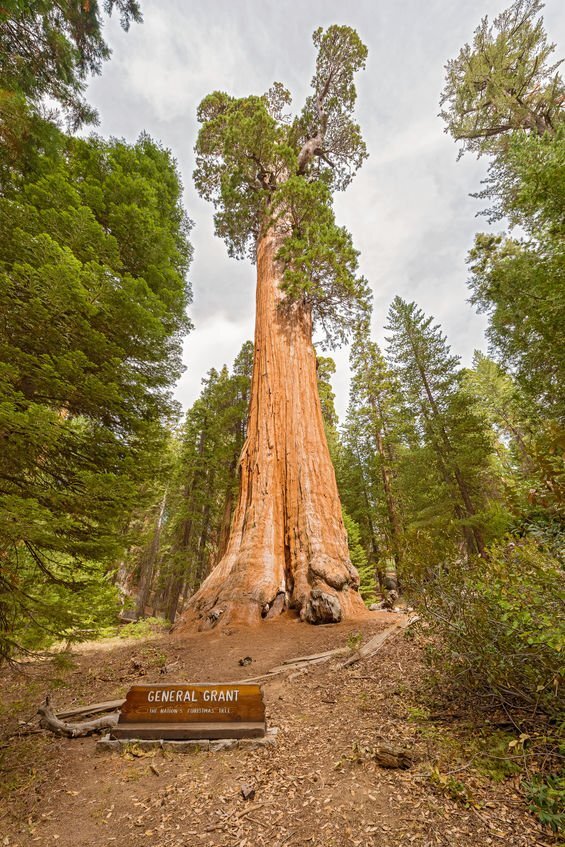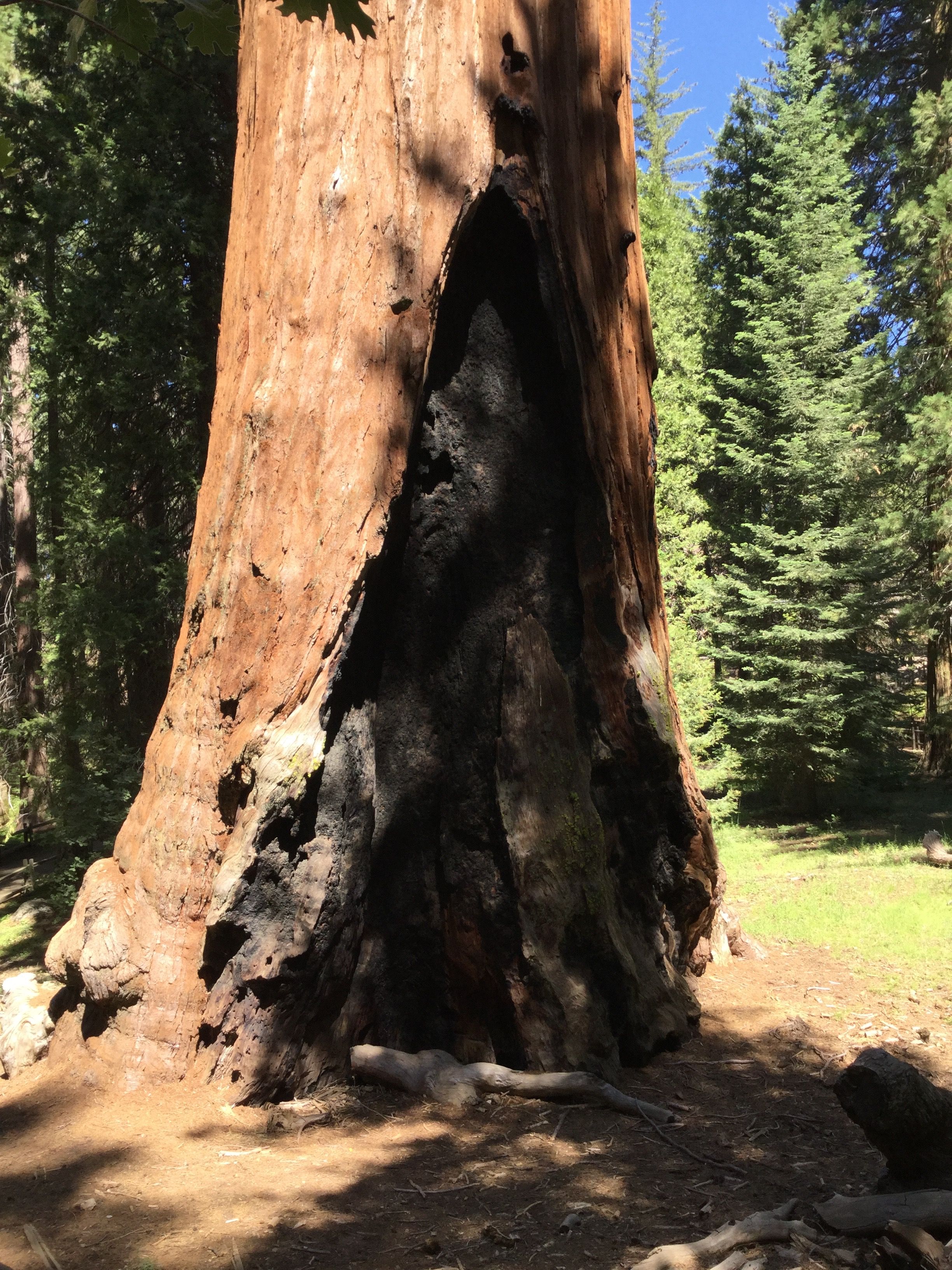
After a couple years, it was nice to see an old friend. Though the turbulent times had made the last months seem like ages, my friend offered perspective, reminding me of a more grounding time off the clock.
You see, my friend is 1700 years old, give or take a century. The General Grant giant sequoia has been standing watch over the passage of seasons, humans indigenous and touristic, and millions of squirrels, deer, robins and blue jays since the Roman Empire was headquartered in Constantinople back in 300 A.D.
Countless empires, plagues, wars, and human struggles have come and gone in the world, while this stalwart has stood watch over this peaceful grove of giants hugging the slopes of Kings Canyon and Sequoia National Park, just outside the village of Grant Grove, California. It was easy to see from the lens of this colossus that the troubles of our moment will pass too, like all the others before them.
THINK SMALL
The Grant is the third largest tree in volume on the planet, thanks to its massive girth. It’s base is so wide, it would take twenty humans to link hands around it.
The first time I saw these whopper trees as a kid, I was floored, not just by their size, but by their age. I remember looking at a cutaway of a tree trunk of one of the giants felled in pre-protected status days. The tree rings inside, which function like a calendar, were matched to historical events going back to B.C. days.
The Grant tree isn’t anywhere near the senior sequoia. The oldest has stood sentinel for 3,266 years. It’s located in the Converse Basin Grove of Giant Sequoia National Monument. Try to imagine this: This tree was alive when pharaoh and mammoth statue-builder, Ramses II, ruled Egypt. Yosemite’s Grizzly Giant is around 3,000 years old, meaning it was here in the Sierras a thousand years before Cleopatra made her entrance.
I’ve visited Grant and his colossal crew many times over the years to marvel at the scale of these massive creatures, be inspired, and also to lose my mind, at least briefly, in the wonder that is expert at overwhelming the fleeting crises and concerns that preoccupy the human brain.
One of the surest ways out of a mind that won't let worries go is to think small. Nature, especially in these enormous dimensions, tells us there is a world beyond the self-referential thoughts we seem to think are the sum total of the universe, beyond momentary dilemmas that feel eternal.
Giant sequoias and forests full of their whipper-snapper brethren, maybe only 400 or 500 years old, give us what we could all use right now: perspective, which is a powerful stress reducer. Perspective is a stress management tool we don’t use enough that lets us step out of our heads to see the larger picture.
This grove offers timeless solidity in a moment of massive change. It tells us that these stressful times are temporary. It inspires us to see beauty and feel peace even if everything else is going to hell around us. This proves we can entertain positive emotions even amid convulsive negativity.
THE POWER OF BEAUTY
Researchers have found that nature—even walking through a city park at lunch time—can lower stress and ease negative mood. It does this by directing attention away from problems and projections to the moment of experience—beautiful landscapes, the aesthetic symmetry of foliage, birdsong, drifting clouds that resemble a turtle or a map of Italy, things that generate positive emotions, which then crowd out the negative.
The experience of natural beauty soothes harried minds so well that it can even be the starting point to bring political opposites together, believes John de Graaf, an award-winning environmental filmmaker and activist who has started a national initiative around the concept, called And Beauty For All. He hopes to stimulate beautification programs in communities across the country by integrating more nature into our day-to-day, such as urban farms, and park and trail developments like the one in Duluth, Minnesota that revitalized the Lake Superior shoreline.
De Graaf believes "all Americans appreciate beauty, regardless of their political views, origin, economic status or creed, and that working to restore beautiful landscapes and create beautiful places is a non-partisan cause that can bring us together and build community in polarizing times."
SLIPPING THE SELF-TALK SCRIPT
One of the ironies of life is that we spend a vast amount of time thinking about ourselves and how important our thoughts are, but we are happier when we are thinking about how small we are in the scheme of things. It’s very hard to think about your problems when you are staring at a night sky in the wilderness, jammed with millions of stars and a Milky Way that splashes across the night like a whitewater river.
Humility is healthy to well-being. The perspective of enormity extracts us from our head and restores the ego to its rightful place, as one of billions traveling on this epic adventure of trial and error.
But it’s not just size that shrinks ego by granting perspective. Many things can give us the distance from ourselves to see that we are more fortunate than we might think. It’s amazing how quickly we can slip the self-talk script by imagining ourselves in other shoes. The evidence is in front of us every day, if we can extract ourselves from rumination and worry.
The University of North Carolina’s Barbara Fredrickson has shown that gratitude is one of the most effective forms of perspective—and stress relief. She has demonstrated that merely spending a minute to think about something you should be grateful for can actually undo the physical symptoms of stress in the body. Digestion starts up again. Heart rate lowers. The immune system reactivates again. She calls it the undo effect.

Giant sequoias undo it for me. It’s not like they have it easy, standing around all the time, pounded by snow and vicious storms that snap off branches, and charred by eons of fires. During a period from 800 A.D. to 1300 A.D. in a time of frequent drought, fires burned through Sequoia National Park’s Giant Forest, which is home to the biggest tree on the planet, the General Sherman giant sequoia, every three to 10 years.
The backside of the General Grant tree is scarred by the blackened remains of fires that have scooped out a large chunk of the trunk a couple feet deep and about 15 feet high. Most giant sequoias show evidence of repeated fire damage.
The bark of the sequoia, though, is extremely resilient. The outer bark is composed of many fiber bundles that act as a cushion against blunt force as well as a fire retardant. It feels like a sponge to the touch, receding, then springing back again when you take your finger off.
The secret to life the sequoia has evolved is a strategy of bouncing back, something we can do too with a little perspective and a lot of standing tall.
If you would like to learn more about my stress management and resilience employee trainings and keynotes, essential in COVID times, please click the button below for details.



